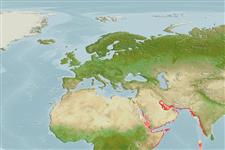Teleostei (teleosts) >
Eupercaria/misc (Various families in series Eupercaria) >
Labridae (Wrasses) > Corinae
Etymology: Halichoeres: Greek, als, alis = salt + Greek, choiros = pig (Ref. 45335).
More on authors: Randall & Smith.
Environment: milieu / climate zone / depth range / distribution range
Ecology
Marine; reef-associated; depth range 3 - 25 m (Ref. 11441). Tropical
Western Indian Ocean: known only from the Persian Gulf and the Gulf of Oman.
Size / Weight / Age
Maturity: Lm ? range ? - ? cm
Max length : 20.3 cm TL male/unsexed; (Ref. 126022); max. published weight: 130.00 g (Ref. 126022)
Dorsal
spines
(total): 9;
Dorsal
soft rays
(total): 12;
Anal
spines: 3;
Anal
soft rays: 11 - 13. Caudal fin slightly to moderately rounded; females whitish with two broad brownish red to yellowish brown stripes, one dorsally on body and the other lateral, ending in a black spot at base of caudal fin; males pale blue and yellow on dorsal half of body (above lateral line, scale centers yellow, edges blue; colors reversed below the lateral line), gradually shading to whitish ventrally; a large U-shaped black mark within the pale blue area on upper side of tip of pectoral fin; a bright blue and yellow spot anteriorly on dorsal fin (first interspinous membrane mainly blue, second mainly yellow).
Life cycle and mating behavior
Maturity | Reproduction | Spawning | Eggs | Fecundity | Larvae
Distinct pairing during breeding (Ref. 205).
Randall, J.E., 1995. Coastal fishes of Oman. University of Hawaii Press, Honolulu, Hawaii. 439 p. (Ref. 11441)
IUCN Red List Status (Ref. 130435)
Threat to humans
Harmless
Human uses
More information
ReferencesAquacultureAquaculture profileStrainsGeneticsElectrophoresesHeritabilityDiseasesProcessingNutrientsMass conversion
Tools
Special reports
Download XML
Internet sources
Estimates based on models
Preferred temperature (Ref.
123201): 26.7 - 29.3, mean 28.2 °C (based on 176 cells).
Phylogenetic diversity index (Ref.
82804): PD
50 = 0.5000 [Uniqueness, from 0.5 = low to 2.0 = high].
Bayesian length-weight: a=0.00955 (0.00556 - 0.01641), b=3.12 (2.97 - 3.27), in cm total length, based on LWR estimates for this species & Genus-body shape (Ref.
93245).
Trophic level (Ref.
69278): 3.5 ±0.5 se; based on size and trophs of closest relatives
Resilience (Ref.
120179): Medium, minimum population doubling time 1.4 - 4.4 years (Preliminary K or Fecundity.).
Fishing Vulnerability (Ref.
59153): Low vulnerability (10 of 100).
